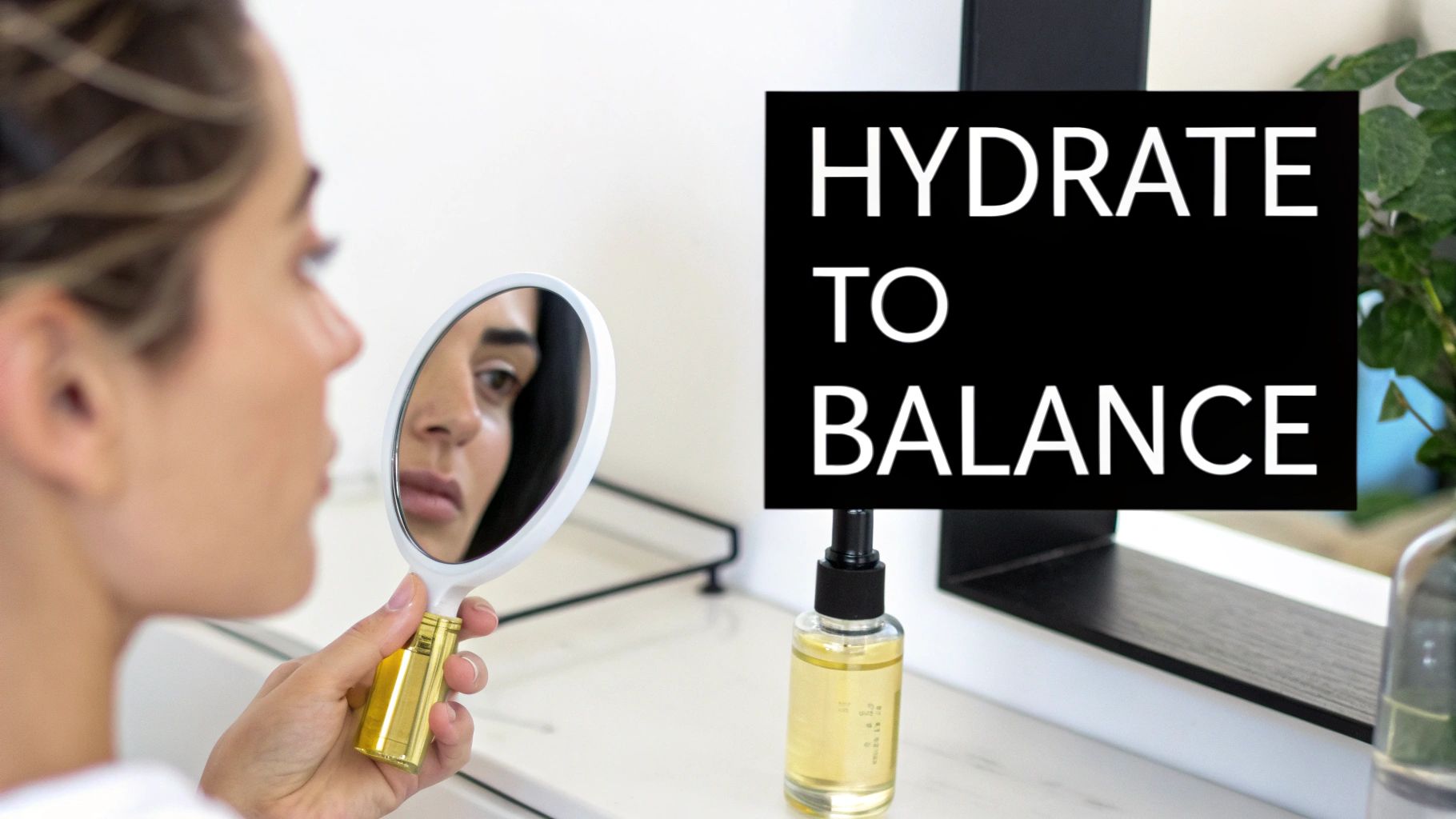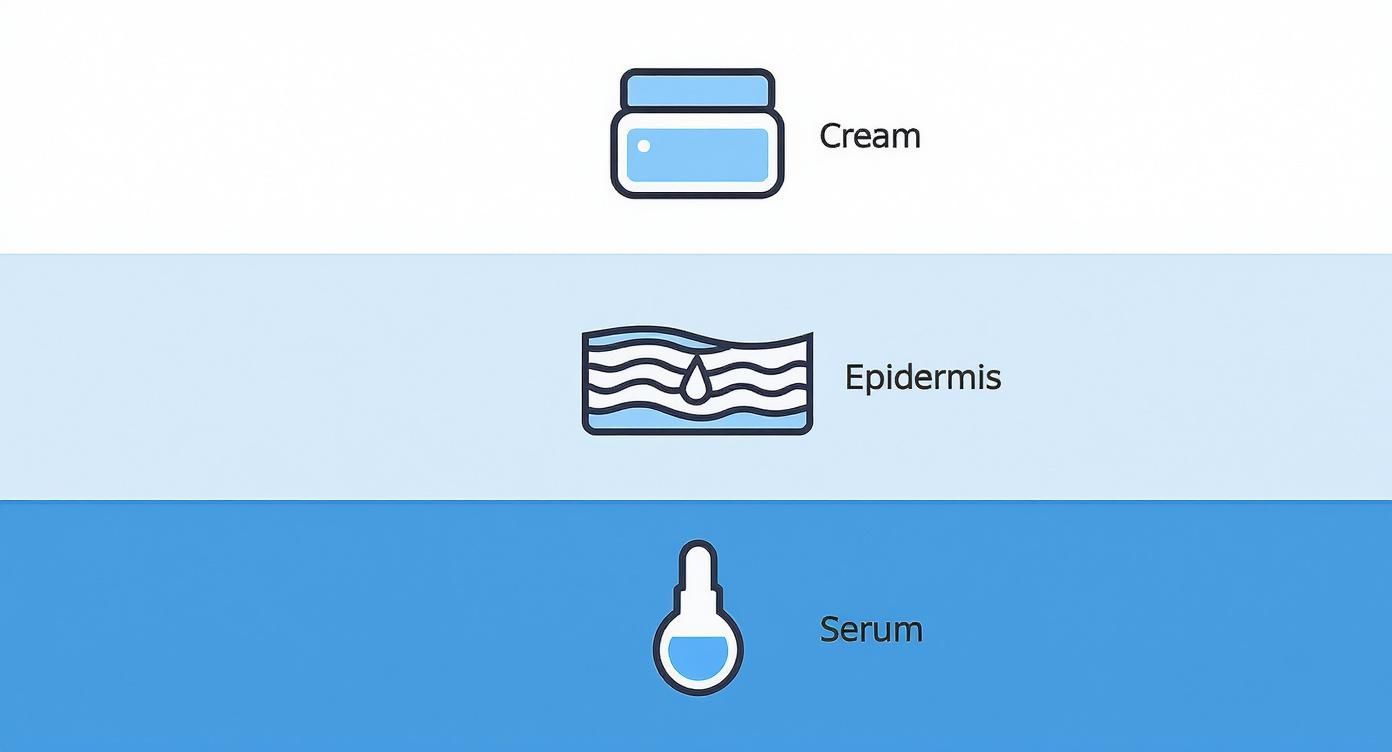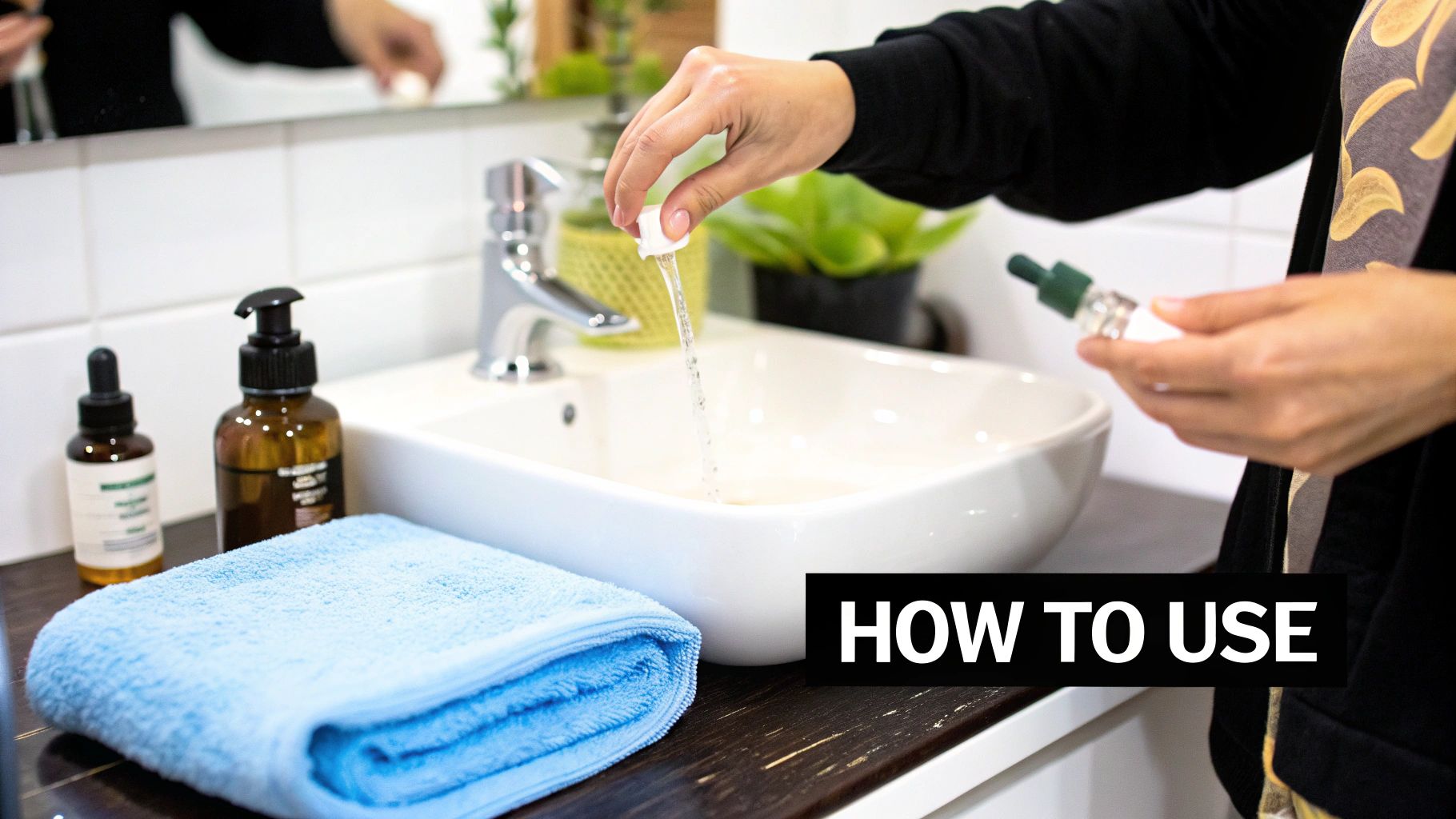Jan Elvis
10.11.2025

Jan Elvis
10.11.2025
If you've got oily skin, the idea of adding a face serum to your routine probably sounds like the last thing you should do. I get it. Why add more moisture to skin that already feels slick? But here's the thing: the right serum is often the secret weapon to finally getting that shine under control. It's not about adding grease; it's about giving your skin what it's actually craving so it can chill out on the oil production.

We've all been there—staring in the mirror at a reflection that’s shinier than we’d like. The knee-jerk reaction is to grab the harshest, most stripping cleansers and toners we can find to dry that oil slick out. The problem is, this approach almost always makes things worse. When you strip away all of your skin's natural oils, it freaks out.
Think of it as your skin’s defense mechanism. It produces oil (sebum) to keep itself hydrated and protected. When you aggressively remove that protective layer, your skin's internal alarm bells go off, and your oil glands get a frantic message: "We're dry! We're vulnerable! Produce more oil, stat!" This kicks off a frustrating cycle of stripping away oil, only to have your skin produce even more to compensate.
This is exactly where a good face serum for oily skin flips the script. Unlike thick, heavy creams that can feel suffocating and clog pores, serums are super lightweight. Their small molecular structure means they sink deep into the skin, delivering a potent shot of active ingredients right where they're needed most.
A serum formulated for oily skin can help restore balance in a few key ways:
A serum essentially recalibrates your skin. By giving it the lightweight hydration it needs, you’re teaching it that it doesn’t have to work so hard to protect itself. It's the key to breaking that vicious cycle and achieving a complexion that’s naturally balanced, not constantly battling shine.
Of course, the first step is always knowing what you're working with. If you're not totally sure about your skin's behavior, check out our guide on how you can tell your skin type. Nailing this down will make choosing the perfect serum a whole lot easier.
Think of a face serum as a targeted strike team for your skin. While heavier creams and lotions are more like a protective blanket sitting on the surface, serums are built differently from the ground up. They're typically super-light, water-based formulas packed with a high concentration of powerful active ingredients.
This unique, fluid-like consistency is their secret weapon. The molecules in a serum are much smaller than those in your average moisturizer, which allows them to dive deeper past the skin's surface and get to work much faster. They don't just hang out on top; they deliver their payload of nutrients right where you need it most.
If you have oily skin, this deep-delivery system is a total game-changer. It means you can tackle the root causes of that extra shine and those enlarged pores without slathering on another heavy, greasy layer. A good face serum for oily skin gives you potent, targeted treatment without the risk of clogging pores, which so often just makes the problem worse.
This feather-light feel is the key to managing that constant shine. Serums sink in almost instantly, leaving behind little to no residue. You get all the benefits of the powerful ingredients without that heavy, mask-like feeling, allowing your skin to just breathe.
The goal of a serum isn't to add more oil or gunk; it's to deliver a concentrated dose of balancing ingredients. It’s about giving your skin the precise tools it needs to regulate itself, leading to a calmer, less reactive complexion.
This efficient delivery ensures that every single drop is pulling its weight. Unlike moisturizers, where a lot of the formula is designed to create a barrier on the surface, a serum’s primary job is to treat and repair from the inside out.
Here’s something many people don’t realize: oily skin is often just dehydrated skin in disguise. When your skin lacks water, it panics and overproduces oil to compensate. A hydrating serum can completely break this frustrating cycle. By delivering deep, water-based moisture, it sends a clear signal to your oil glands that everything is balanced, so they can finally chill out.
Here’s how a serum helps get your skin back on track:
This entire approach is so much smarter than just trying to strip the oil off your face. Instead of fighting your skin, you’re working with it, giving it the balance it's craving to function at its best. This leads to real, lasting improvements, not just a temporary fix. It’s a more direct path to that clear, shine-free look we're all after.
Trying to read an ingredient label can feel like you’re trying to crack a secret code. But to find the best face serum for oily skin, you need to become a bit of a codebreaker. The trick is to focus on the powerhouse ingredients that actually make a difference for a shiny complexion.
These actives are the real workhorses in any formula—they’re what regulate oil, clear out congested pores, and deliver that tricky balance of hydration your skin craves. It’s all about looking past the flashy marketing and getting down to the science of what works.
This diagram helps show why serums are so effective. Their tiny molecules can penetrate much deeper into the skin than a heavy cream, delivering those powerful ingredients right where they're needed most.

This deep delivery system is a game-changer for oily skin because it bypasses the surface to tackle problems like excess sebum right at the source.
If I had to pick one superstar for oily and congested skin, it would be Niacinamide. This form of vitamin B3 is a true master of balance, helping to regulate and normalize your skin’s sebum production over time. Think of it as a smart thermostat for your oil glands, gently telling them to chill out when they start working overtime.
This regulation has a fantastic side effect: your pores start to look smaller. When they aren't constantly stretched out by excess oil and gunk, their appearance is visibly minimized. On top of that, studies show niacinamide helps strengthen the skin’s natural barrier, which is absolutely crucial for keeping your skin healthy and resilient.
Clogged pores got you down? Salicylic Acid is your best friend. As a beta-hydroxy acid (BHA), it’s oil-soluble. That’s a fancy way of saying it can dive deep inside your pores to dissolve the junk—like dead skin cells, excess oil, and daily grime—that leads to breakouts and blackheads.
Unlike other exfoliants that just work on the surface, Salicylic Acid does a proper deep clean from the inside out.
Key Takeaway: Salicylic Acid doesn't just treat existing blemishes; its deep-cleaning action helps prevent new ones from forming, making it a critical ingredient for maintaining clear, smooth skin.
Let’s get one thing straight: even the oiliest skin needs hydration. Stripping your skin of moisture will only make it produce more oil to compensate. This is where Hyaluronic Acid (HA) comes in to save the day.
It’s a humectant, which means it pulls moisture from the air and locks it into your skin. In fact, it can hold up to 1,000 times its weight in water. This gives your skin an intense dose of hydration without adding a single drop of oil, quenching its thirst and signaling that it can calm down on the sebum production. The result is skin that feels plump and refreshed, never greasy.
While the "big three" do most of the heavy lifting, a few other ingredients play fantastic supporting roles. Think of them as the backup singers that make the whole performance better.
Here's a quick look at some of the most effective ingredients you'll find in serums for oily skin.
| Ingredient | Primary Benefit | Best For |
|---|---|---|
| Niacinamide | Regulates oil & minimizes pores | Visible pores, excess shine, redness |
| Salicylic Acid | Deep-cleans pores & exfoliates | Blackheads, whiteheads, acne-prone skin |
| Hyaluronic Acid | Oil-free hydration | Dehydrated skin that still feels oily |
| Zinc | Calms inflammation & redness | Acne flare-ups and irritation |
| Green Tea Extract | Antioxidant & soothing | Protecting skin and reducing inflammation |
| Witch Hazel | Astringent & oil-absorbing | Temporarily tightening pores and surface oil |
This table is a great starting point, but don't be afraid to explore other natural helpers. For instance, you can learn more about the benefits of ingredients like grape seed extract, which offers powerful antioxidant protection.
The key is to look for a thoughtfully formulated product that combines a few of these ingredients to tackle oily skin from multiple angles.
It sounds completely backward, doesn't it? The idea of putting oil on already oily skin. For decades, we've been told that "oil-free" is the only way to get a handle on that constant shine. But what if that advice has been leading us down the wrong path?
The truth is, this "oil-free" mantra is a huge misconception. Not all oils are the villains they're made out to be. While thick, pore-clogging (comedogenic) oils can absolutely spell trouble for your skin, the right oils can be your greatest ally in the fight for balance.
Think of it as a quiet conversation with your skin. When you apply a lightweight, non-comedogenic oil, you're essentially telling your sebaceous glands, "It's okay, we've got enough moisture here. You can dial it back a bit." This simple signal can convince them to stop working overtime, helping to calm that frantic oil production.
This whole approach is about working with your skin's natural processes, not waging war against them. Constantly stripping your skin with harsh, oil-free products sends it into a panic, triggering an endless cycle of more shine and irritation. A face serum for oily skin that's formulated with beneficial oils helps bring things back into equilibrium.
Some of the best oils for the job are surprisingly light and effective:
By introducing these "smart" oils, you’re providing the balanced moisture your skin is craving. This helps it find its happy medium, leading to a complexion that is healthier, calmer, and less reactive over time.
This rebalancing act is becoming a cornerstone of modern skincare. In fact, oil-based serums are seeing a huge surge in popularity. The global facial serum market was valued at $5.84 billion in 2024, and it's still growing. Formulas with botanical oils are projected to grow at a rate of 7.6% through 2030, largely because people are finally understanding how the right oils can moisturize and balance oily skin. You can discover more about these market trends and consumer insights from Grand View Research.
Choosing a serum with these non-comedogenic oils isn't just a trend; it's a strategic move toward long-term skin health. It proves that fighting oil with oil isn't a myth—it's just smart skincare science.

So, you've found the perfect face serum for oily skin. That’s a huge win! But getting the results you want isn't just about what you use—it's about how you use it. Proper application ensures every potent drop actually gets to work instead of just sitting on the surface.
Think of it this way: your serum is the star player. Cleansing and toning are the warm-up, and your moisturizer is the cool-down. The order is everything. You'll always want to apply your serum after cleansing and toning, but right before your moisturizer.
Why? Serums are thin, concentrated formulas designed to dive deep into your skin. Slathering on a thick cream first is like putting up a roadblock; the serum simply can't get through.
Getting the application right is simple once you know the drill. Follow this sequence to make sure your skin soaks up all the goodness without any wasted product.
If you want a more detailed look at how all your products should fit together, our guide on the proper skin care order of application breaks it all down.
Pro Tip: Try applying your serum while your skin is still slightly damp from cleansing or toning. A little bit of moisture on the surface can act as a carrier, helping those active ingredients penetrate even more effectively.
When you apply your serum is just as important as how. Hydrating serums with ingredients like niacinamide or hyaluronic acid are perfect for both morning and night.
But if your serum contains exfoliants like salicylic acid, stick to using it in your evening routine. These ingredients can make your skin more sensitive to sunlight, so it's best to let them work their magic overnight.
And no matter what, sunscreen every single morning is a must. It's non-negotiable. Protecting your skin from UV rays is the single best thing you can do to keep it healthy and see the best results from your products.
Consistency is what will truly get you that clearer, more balanced complexion you’re after. Stick with it, and your skin will thank you.
Dealing with oily skin isn't about waging war on shine; it's about finding harmony. As we've covered, the right face serum for oily skin can be your secret weapon, delivering concentrated doses of ingredients like niacinamide and salicylic acid deep into your pores. It's time to stop seeing that midday sheen as an enemy to be brutally stripped away.
We've busted the myth that all oils are bad for oily skin and laid out a simple plan for how and when to apply your serum. With this insight, you can finally stop guessing and start choosing products that cooperate with your skin's natural rhythm. Just remember, consistency is what truly brings results.
Think of your skincare routine as a conversation. When you give your skin the right serum, you're not just treating it—you're teaching it how to rebalance itself for a calmer, clearer future.
As you add a serum to your lineup, don't forget about its teammates. A great toner, for instance, does more than just feel refreshing—it preps the canvas by rebalancing your skin's pH after cleansing, making it perfectly receptive to the serum that follows.
To round out your routine and maximize your results, check out our guide to the best skin toners that work beautifully alongside a targeted serum.
You've got the roadmap now. Making these smart, informed choices is the first real step toward a healthy, balanced complexion you can feel good about.
Even with the best plan in place, it's normal to have a few lingering questions about using a face serum for oily skin. Nailing down the details is what takes a skincare routine from good to great. Let's tackle some of the most common ones.
Yes, you absolutely can—and you should! Most serums made for oily skin are formulated to be gentle enough for daily, even twice-daily, use. This is especially true for hydrating formulas with ingredients like niacinamide or hyaluronic acid. Consistency is the secret sauce that helps your skin find its balance.
Now, if you're using a serum with more potent actives like salicylic acid, it’s smart to ease into it. Start by applying it every other night to see how your skin responds. If everything looks good and there's no irritation, you can gradually increase it to daily use.
This is a huge one, and the answer is a resounding yes. Serums and moisturizers play two very different, but equally critical, roles on your team. Think of them as a dynamic duo for your skin.
Skipping the moisturizer means all those wonderful hydrating ingredients in your serum can simply evaporate off your skin. For oily types, the trick is to follow up with a lightweight, non-comedogenic moisturizer, preferably a gel or water-based formula.
Think of it this way: your serum is the specialist brought in to fix a specific problem, and your moisturizer is the protective layer that makes sure the job gets done right. You need both.
When it comes to skincare, patience isn't just a virtue; it's a necessity. You might notice your skin feeling softer or looking a bit more hydrated right after you apply a serum, which is a great start. But the real, lasting changes take a bit more time.
Generally, you can expect to see noticeable improvements in oiliness, pore appearance, and overall texture within four to eight weeks of consistent use. Why so long? That’s roughly how much time your skin needs for a full cell turnover cycle. Stick with it every day, and trust that you're playing the long game. The payoff is definitely worth it.
Ready to help your skin find its happy place? The Main Character collection is all about building a simple, effective routine that gets you real results. Take a look at our products and start your journey to a clearer, more confident you.